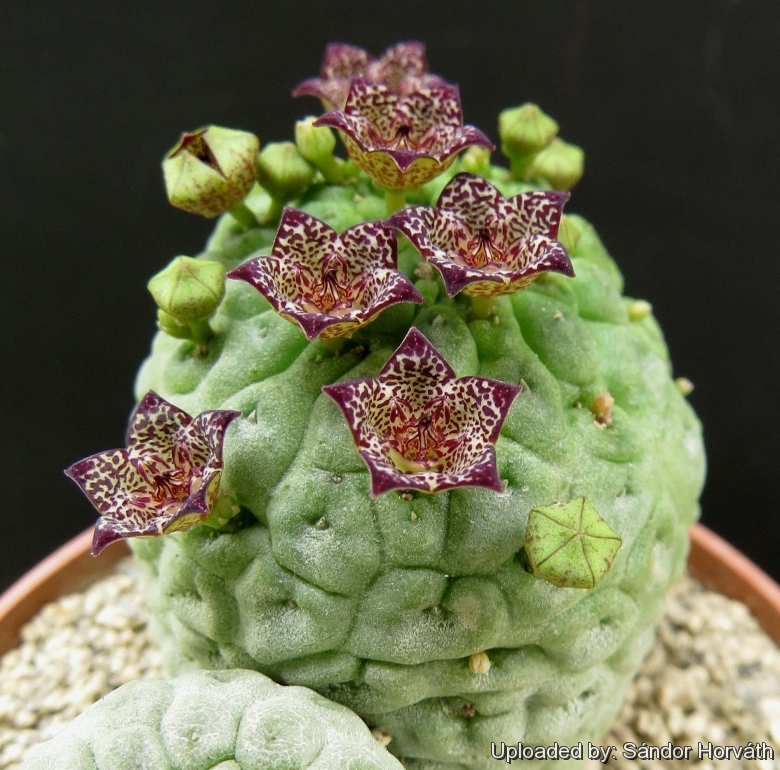Accepted Scientific Name: Larryleachia cactiformis (Hook.) Plowes
Excelsa 17: 5 (1996)

Larryleachia similis Photo by: Sándor Horváth
Origin and Habitat: Southern Namibia to northern Cape (South Africa)
Synonyms:
See all synonyms of Larryleachia cactiformis
Common Names include:
AFRIKAANS (Afrikaans): ghaap
Description: Larryleachia similisSN|18662]]SN|18670]], formerly knows as Trichocaulon simileSN|18671]]SN|18671]] is a perennial succulent with stems resembling that of Larryleachia cactiformisSN|18670]]SN|18662]]. It is a small globular globular to oblong succulent distinguished from Larryleachia cactiformisSN|18662]]SN|18662]] for its cup-shaped corolla that encloses the corona, however the distinguishing characteristics of this plant, appear to fall within the natural variation of Larryleachia cactiformisSN|18662]]SN|18662]] and it should be synonymized with the latter. Larryleachia similisSN|18662]]SN|18670]] (whatever this plant is) still has a value for a collector because they identify plants with particular characters.
Stems: Oblong or globose-obovoid, tapering upwards, greyish-green 5-9 (or more?) cm high and 4-6 cm thick, quite smooth, only a little wrinkled, covered with irregular hexagonal tubercles, that are more prominent than in Larryleachia cactiformisSN|18670]]SN|18662]], the youngest near the apex tipped with a small apiculus or bristle (a minute conical leaf less than 1 mm long and 1 mm broad).
Flowers: At the apex of the stems, opening in succession until a number are open together. Pedicels 2-3 mm long, glabrous. Calyx-lobes (sepals) 1-2 mm long and quite as broad, broadly ovate, acute, glabrous. Corolla 9-15 mm in diameter, green outside with copious reddish-brown blotches giving it a brown appearance, pale greenish-yellow above, with round dark brown-red spots, campanulate, quite glabrous and not ciliate on the lobes, smooth outside, minutely papillate-rugulose on the inner face of the lobes, deep purple-brown. Tube 3 mm long, 5-6 mm in diameter outside, cup-shaped, with fleshy ridges from the sinuses to the floor of the tube, cream-colored in the lower part, the upper part and the lobes with numerous dark red spots. Lobes spreading, 3-4 mm long, 5 mm in breadth, broadly ovate to triangular in outline, acute, reflexed. Outer corona shortly cupular at the base, 5-lobed, with each lobe deeply trifid and with the apices of the two lateral red teeth converging slightly over the somewhat shorter central spotted tooth, the two lateral teeth longer than and arching over the middle tooth, suberect, rising to the level of the inner corona, 1.5-2 mm long. Inner corona-lobes copiously spotted, 1-1.5 mm long, flat, oblong-linear, obtuse, ascending-connivent, closely pressed to the backs of the anthers and then ascending, converging to form a column for 1 mm. of their length, dorsally connected at the base to the cup of the outer corona.
Bibliography: Major references and further lectures
1) N. E. Brown “Flora Capensis”, Vol 4, 1909
2) Alain Campbell White, Boyd L. Sloane “The Stapelieae”, Volume 3 Typography and printing by S. E. Haselton at Abbey San Encino Press, 1937
3) Botanical Research Institute, Department of Agricultural Technical Services, Republic of South Africa “The Flowering Plants of Africa”, Volume 16, page 620, 1936
4) Botanical Research Institute (South Africa), South Africa. Dept. of Agricultural Technical Services “The Flowering Plants of Africa: A Magazine Containing Coloured Figures with Descriptions of the Flowering Plants Indigenous in Africa”, Volume 18 1938
Cultivation and Propagation: Larryleachia similisSN|18670]]SN|18670]] is a slow growing species of relatively easy culture. If grown correctly, it will reward the grower with generous displays of flowers.
Potting medium: Since roots are quite shallow, use a cactus mix or add extra perlite or pumice to regular soil potting soil. A gritty, very free-draining compost is suitable, and clay pots help the plants to dry out between watering.
Fertilization: Feed with a high potassium fertilizer in summer.
Light requirements: High levels of light are needed to flower and for good development. Can be sunburned if moved from shade/greenhouse into full sun too quickly. During the spring it may be able to take full sun until the heat arrives at the end of spring. In an area that has hot afternoon sun, it may be able to take full morning sun, but requires afternoon shade or afternoon light shade.
Watering Needs: water normally in the growing season, but do not overwater (very wet-sensitively, especially in light of its small root system) Water thoroughly only if soil is dry to the touch, let soil dry in between to prevent root rot, keep dry in the winter with ample airflow. Care must be taken with watering as they tends to become swollen and untidy in growth habit if given too much water and shade.
Hardiness: It is quite frost resistant if kept dry, hardy as low as -5° C (or less)
Propagation: Seeds or division, wait until the offsets that appear at the base of old clustered specimens are 1/3 the size of the parent and then detach and plant.










